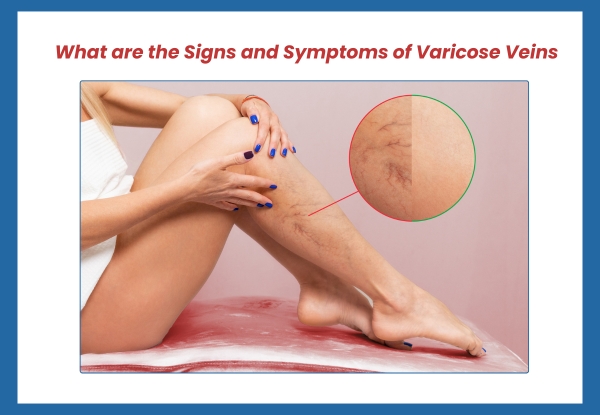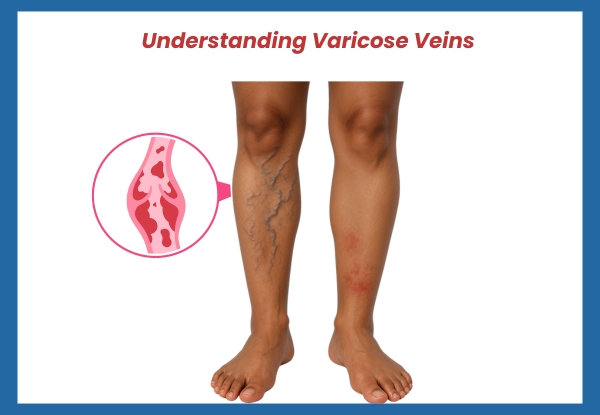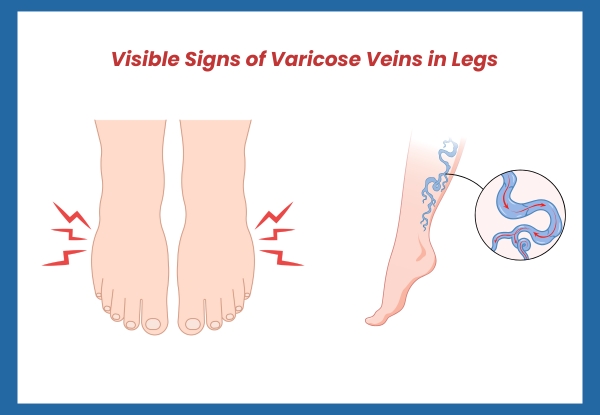
Introduction
Noticing unusual changes in your legs? You might be asking yourself what are the signs and symptoms of varicose veins. It’s a concern shared by many, especially those who spend long hours on their feet or have a family history of vein-related issues. Varicose veins can start off as a minor cosmetic issue but may develop into a more uncomfortable or even painful condition if left unchecked.
Understanding the early indicators can make all the difference in seeking timely support and preventing further complications. This guide outlines the key physical signs and feelings associated with varicose veins, helping you recognise whether it’s time to consult a healthcare professional.
Understanding Varicose Veins

Varicose veins are swollen blood vessels that usually develop in the legs. These veins become enlarged when their valves, which normally keep blood flowing in the right direction, begin to weaken or fail. As a result, blood collects, causing the veins to stretch and twist.
They often appear close to the skin’s surface and are usually visible as blue or purple rope-like lines. While they are typically found in the legs, they can sometimes affect other parts of the body.
This condition affects circulation and, over time, can lead to discomfort or more serious concerns. It’s helpful to understand what causes varicose veins before looking at the symptoms they bring. Factors like increased pressure in the legs, extended periods of standing, and changes in hormone levels all play a part in their development.
Early Signs You Shouldn’t Ignore
Varicose veins often begin with mild, easy-to-miss signs. Recognising these at the start can make a real difference, especially if treatment or lifestyle adjustments are needed later.
Watch for:
- A feeling of heaviness or tiredness in the legs
- Swelling in the lower legs or ankles, particularly after standing
- Subtle itching or discomfort around the veins
- A slight presence of blue or purple under the layer of skin.
These early symptoms of varicose veins are often mistaken for general fatigue or minor aches. However, they are important signals that your veins might not be functioning as they should.
When to Worry About Varicose Veins
There are moments when varicose veins require medical attention. Knowing what to watch for can help prevent more serious problems.
These warning signs include:
- A vein that bleeds without any clear reason
- Open sores or ulcers near the ankles
- Sudden swelling in one leg, which may feel warm or tight
- Skin that becomes red, hard, or painful to touch
If any of these signs appear, it’s best to consult a healthcare provider. These symptoms might point to complications beyond surface vein issues.
You can speak with a specialist at Midas Care Clinic, known by many as the Best Diagnostic Center in Mumbai for vein and vascular care.
Visible Signs of Varicose Veins in Legs

The physical symptoms become more noticeable as the illness worsens. You could start to notice:
- Veins that are blue or purple and emerge at the skin’s surface
- Large, twisted, or protruding veins
- Colour changes around the veins
- Spider veins are groups of tiny, red or blue vessels.
These changes are most often seen on the calves, behind the knees or along the thighs. The veins might feel firm when touched or seem raised above the skin surface.
People sometimes confuse spider veins with varicose veins. Spider veins are smaller and tend to be harmless, but they can point to underlying venous issues.
Physical Sensations and Discomfort
Varicose veins induce discomfort that fluctuates among individuals. While one person might experience a dull ache, another could deal with sharper pain or regular cramping.
Common symptoms include:
- Aching or throbbing, especially after prolonged standing
- Burning sensations or warmth in affected areas
- Muscle cramps during the night
- Skin that feels tight or irritated near the veins
These issues tend to worsen in hot weather or after long periods of movement or inactivity. The veins themselves may become more swollen by evening, then appear less prominent by morning.
These signs shouldn’t be ignored. They are more than skin-deep. They indicate changes in blood flow and vessel pressure that can lead to complications if left untreated.
Common Misconceptions and Similar Conditions
Varicose veins are not present in all visible vein issues. It’s important to understand the difference.
For example:
- Spider veins are much smaller and closer to the skin surface. They are often cosmetic and do not cause pain.
- Deep vein issues, such as clots, are a separate concern and carry different risks.
- Leg swelling might also result from other conditions such as fluid retention, not vein malfunction.
Understanding these distinctions can guide better decisions about care and treatment.
Who is at Risk of Developing Varicose Veins
While anyone can develop varicose veins, some people are more likely than others due to lifestyle or genetic factors. You may be at higher risk if:
- You have a family history of varicose veins
- You’re pregnant or have been pregnant more than once
- Your job involves standing for long periods, such as teaching or nursing
- You’re overweight or obese
- You lead a sedentary lifestyle
- You’re over 40 years old
Women are generally more affected than men, especially during or after pregnancy. Hormonal shifts, combined with added pressure on the veins, can make symptoms appear earlier in life.
If any of these apply to you, keeping an eye on the early symptoms of varicose veins and seeking support from trusted facilities like the Best Diagnostic Center in Mumbai may help in taking timely action.
How Varicose Veins Affect Daily Life
Varicose veins do more than change how your legs look. They can affect mobility, mood, and energy levels.
People often experience:
- Discomfort while walking or standing for long periods
- Sleep interruption from cramps or pain
- Emotional distress from visible changes on the skin
- Clothing choices affected by how legs appear
These impacts, though not life-threatening, can build up and influence how someone feels each day.
Frequently Asked Questions
Q1. What are the early symptoms of varicose veins?
Answer: Mild swelling, aching legs, and small blue or purple veins that begin to show are usually the first signs.
Q2. Do varicose veins hurt?
Answer: Some people feel heaviness or throbbing. Others may have no pain but notice changes in appearance.
Q3. Should I worry about varicose veins during pregnancy?
Answer: They are common in pregnancy but should be checked if they cause discomfort or swelling.
Q4. When should I see a doctor about varicose veins?
Answer: See a doctor if you notice sudden swelling, pain, or skin changes near the veins.
Q5. Are spider veins and varicose veins the same?
Answer: No. Spider veins are smaller, closer to the surface, and usually painless.
Q6. Can varicose veins lead to serious health issues?
Answer: In some cases, yes. Untreated varicose veins may lead to ulcers, blood clots, or skin infections.
Q7. Do varicose veins go away on their own?
Answer: They typically do not disappear without treatment or intervention.
Q8. What’s the difference between varicose veins and swelling from other causes?
Answer: Varicose swelling usually appears with visible vein changes, while other swelling might not.
Conclusion
Recognising the signs and symptoms of varicose veins can lead to better outcomes. Whether you’re seeing early changes or dealing with more advanced symptoms, knowing what to look for matters. At Midas Care Clinic, we focus on clear diagnosis and individualised care for those concerned about vein health. Reach out to our team if you are looking for reliable support at one of the most trusted facilities in Mumbai.

